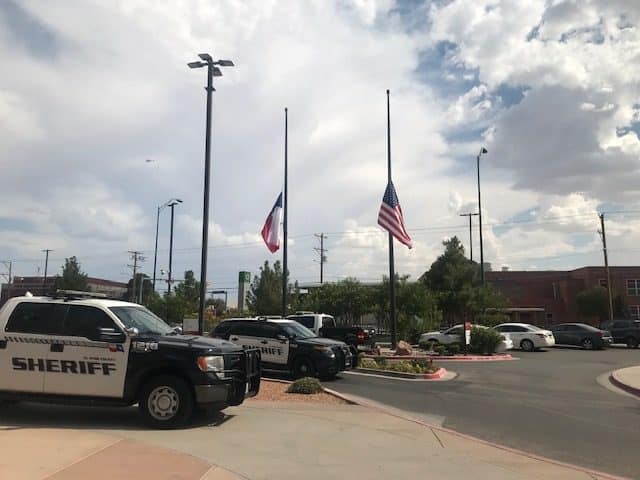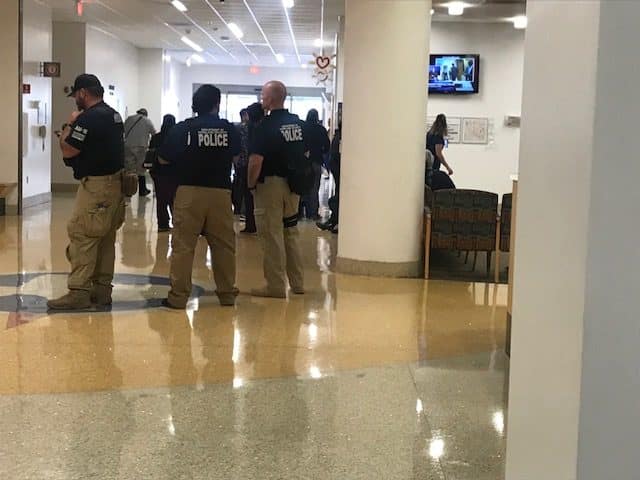
As soon as I awoke yesterday morning in my El Paso hotel room, I turned on the local news station to find out whether Donald Trump was still planning to travel to El Paso to meet with the shooting victims and their families, even though a number of legislative leaders here did not want him to do so. It was confirmed that he was indeed planning to travel to El Paso’s University Medical Center, with an approximate arrival time of 12:30pm.
In hopes of covering Trump’s arrival and his meeting with the shooting victims and their families, I arrived at 11:30am, parked off site, and then crossed the street to the Medical Center. The streets were completely closed off by police cars, and armed officers were starting to circle the building. But I walked right in, through the large entrance doors that automatically opened for me.
I was wearing a black cap, aviator sunglasses, and a black fanny pack around my waist, which carried my cell phone, passport, credit cards and some cash. In my large black satchel, which was draped over my shoulder, was an iPad, a bottle of water, and charging equipment.
No one at the hospital asked who I was, what I was doing there, or what was in my bag. Walking through the lobby, I found a table just beyond the registration desk where I sat down, plugged in…and waited.
Approximately thirty minutes later, the area just beyond the registration desk, and directly in front of where I was already sitting, was roped off. Security guards were positioned on each side, as a man wearing a hospital ID instructed them, “No one is allowed past these ropes without an official ID.” I was sitting just beyond the roped off entrance and, still, no one asked me to leave, or inquired about who I was or what was in my large black bag.

As it got closer to Trump’s arrival, which was now rescheduled for 2:30pm, additional guards appeared as security increased. After remaining seated for a couple of hours, I asked a staff member for the closest bathroom, but she told me that the only one was on the other side of the registration desk. I knew if I walked past that desk, I would never be allowed back in. So I wandered around the hospital’s first floor to see if I could find one on my own, which I did. I felt completely free to go anywhere, take any of the elevators to any floor, including the floors where patients are being cared for, and to the ICU, where the victims of the mass shooting were recovering. I even walked past a number of security guards on my way, including Department of Homeland Security officers, with their guns strapped to their waists to protect any threats to Donald Trump. Still, no one asked me about my identity.
I wondered how Trump would have felt, had he known that an unidentified woman, who traveled hundreds of miles from another state, carrying a non-inspected bag, was waiting for hours in the building he was planning to visit, and specifically for him to arrive. Would he have felt uncomfortable…threatened…even terrified? Would he have even cancelled his visit for security reasons?
This is what ordinary civilians in our country are feeling every single day, and no number of police officers or security guards with weapons will sufficiently protect us. For people of color, this fear is magnified, and rightly so, by the anti-immigration rhetoric being spewed at the highest levels of our country’s office. Truly, if an unidentified person can walk freely through a secured building, roped off with armed officers at every turn, what protections are there for those who are in buildings where there is no security at all, I wondered.
Trump ultimately arrived at the Medical Center at 4:30pm. But no one would have known, since every precaution was taken to ensure his arrival was done in secret. His safety was completely protected. Journalists were not even allowed into the rooms where Trump was supposed to be meeting with the victims and their families although, according to an article in today’s Washington Post, the actuality of these meetings is now questionable.
Yet anyone could have walked into one of the Medical Center’s elevators before or after his arrival, pressed the button to be taken directly to the ICU where the shooting victims were being cared for, opening them up to the possibility of being victimized, yet again. I guess it’s easy to keep weapons out on the streets, and in the hands of just about anybody who wants one, when one’s body is guarded twenty-four hours a day, seven days a week. Clearly, for everyone else, it is only the complete removal of these weapons that will provide safety for those who do not live with this level of security.
Once it became clear that there would be no Trump sighting after all, I walked out of the Medical Center toward my car across the highway, but was stopped by a member of the Secret Service. “You can’t leave until the President leaves,” he told me. “We are trying to keep the protestors away from the hospital, and if they see a civilian like you walking in this sealed-off area, they will have cause to be here as well.” Learning there were protestors just a few hundred yards away, I then tried to leave the hospital grounds through another road in hopes of interviewing them, since their voices were not being heard. But I was stopped again, this time by officers holding rifles that rivaled their own physical size.
Exhausted, I then walked to one of the benches outside the Medical Center, and sat in 100-degree weather alongside another woman, an older woman of Mexican descent, who was complaining about having to sit in the exhausting heat, and couldn’t wait to get back home. I shared my bottle of cold water with her, as we both sat there, and we waited.

Approximately thirty minutes later, the police cars which were blocking all roads and entrances to the hospital, started to depart. This signaled that Trump had officially left, although there was no sign of him doing so. As I drove back to my hotel, I was particularly struck by the sight of a huge building located just one quarter-mile from the Medical Center, emblazoned with the words, ‘GUNS AMMO. EASY PARCEL SHIPPING,’ along with a contact phone number in similarly large letters beside it. While the hypocrisy of this sign struck me, it couldn’t have served as a truer metaphor for what Trump said after his hospital visit that day, where no journalists were allowed: “The respect for the office of the presidency, I wish you could have been in there to see it. I wish you could have been in there.”
